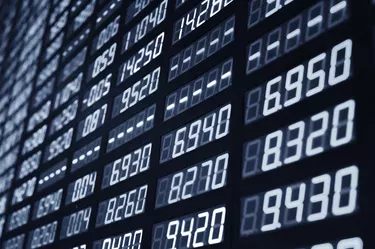
It's common for market indexes, including the S&P 500, to gain or lose less than 1 percent per day. When the market swings up and down to a significant degree and with great frequency, investors describe the market as volatile. The greater the degree and frequency of the swings, the more volatile the market.
A Measure of Market Volatility
Video of the Day
You calculate stock volatility or market volatility by finding the standard deviation of market price changes over a time period. A standard deviation indicates the degree to which stock price differs from an average value. The greater the standard deviation, the more a stock price differs, in one direction or another, from the average.
Video of the Day
What's more, a standard deviation offers the basis to forecast the likelihood a market's volatility will be of a certain degree. For instance, the Empirical Rule says that 68 percent of the time, data, such as stock price changes, will be within one standard deviation of the average, 95 percent of the time they'll be within two standard deviations of the mean and 99.7 percent of the time they'll be within three.
The Standard Deviation and Market Volatility
A trader uses the end-of-day trading values, changes to values within a trading session and projected changes in values to calculate the standard deviations of market prices. For instance, the VIX, or the Chicago Board Options Exchange Volatility Index, uses the projected changes in values to gauge the standard deviations of the market.
Stock Price Volatility
An investor or trader takes the standard deviation of a stock's annualized returns over a certain period to understand the range in which a stock's price might rise or fall. When a stock price fluctuates widely in a short time, it's said to be highly volatile. In contrast, a stock price that fluctuates little is said to have low volatility.
Many investors and brokers rely on the Chicago Board Options Exchange Volatility index to gauge stock price movement and calculate stock volatility.
The Options Exchange Volatility Index
The Chicago Board Options Exchange Volatility Index, or "fear index," measures investor expectations about stock price movement for the subsequent 30 days according to the S&P 500 options trading. The index charts trader expectations regarding the degree S&P 500 prices will move up and down in the following 30 days.
The higher the VIX, the higher the cost of options. Puts, the agreements for traders to sell shares at a certain price and time, become more expensive as it becomes more likely the S&P 500 will fall in value. When the S&P 500 falls below the price of their puts, the traders earn a profit.
Predictor of Market Declines
Consequently, a rise in the value of the puts serves as a predictor of anticipated market declines and, as a result, price volatility. The reason being that when there is an overall downward trend, the stock market registers more drastic changes in value up or down.
Typically, the normal levels of VIX are in the low 20s. This means the S&P 500 will diverge from its average growth rate by no more the 20 percent. If economic anxiety sets in, the VIX may reach the 40s or 50s level.
VIX Volatility Index - Historical Chart
As the Macrotrends VIX Volatility Index - Historical Chart indicates, during a given year, investors may see volatility of about 15 percent from average returns. Once in five years, the market may go down about 30 percent. Most of the time, the stock market is fairly calm.
According to Fisher Investments, a bull or upward trending market is often associated with low volatility and a bearish or downward-trending market with higher volatility.
- Fisher Investments: Stock Market Volatility
- Dummies: Applying the Empirical Rule (68-95-99.7) to a Statistical Data Set
- MacroTrends: VIX Volatility Index - Historical Chart
- Fidelity.com: Understanding Stock Market Volatility and How It Could Help You
- Financial Samurai: Average Daily Percent Move Of The Stock Market: S&P Volatility Returns